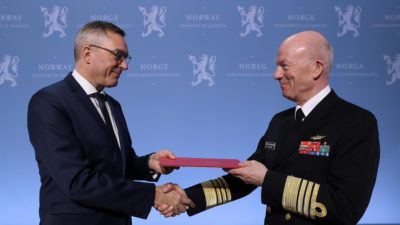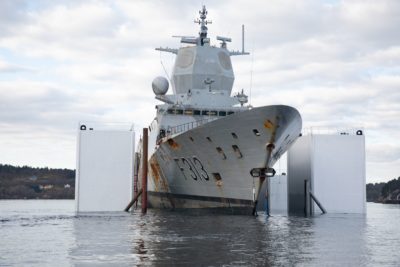Norwegian defense chief Haakon Bruun-Hanssen is asking for, and may well receive, an extra NOK 25 billion (USD 3 billion) over the next eight years to build up the country’s defense. He and other military experts believe Russia would want to blockade Norway in the event of a conflict, meaning Norway must be able to defend itself and keep access open for NATO reinforcements.

Both Bruun-Hanssen and Defense Minister Frank Bakke-Jensen worry that “in a crisis or conflict situation, Norway could find itself behind Russia’s defense line.” Both Norway and NATO were concerned when Russia recently carried out major air-and naval exercises off the Norwegian coast and in the Baltic. Now it’s not just the Barents Sea that needs strong defense presence, but the Norwegian Sea as well.
There have also been incidents in which Russian military aircraft flew in what’s viewed as attack formation, Russian fighter jets have flown just outside Norwegian air space for several years and Russian submarines are believed to have been active as well. The Norwegian website aldrimer.no (the name of which reflects that Norway should “never again” be as defenseless as it was when Nazi Germany invaded in 1940) reported last week that Russian special forces had crossed the border and were on the ground in Norway and Svalbard. Those reports were firmly denied by Russian officials and Norwegian intelligence and military officials claimed they had no such information to confirm them, while newspaper Aftenposten reported over the weekend that Russian special forces were on Svalbard a few years ago and even published photos on social media to boast of their presence.
Provocations on both sides
It’s all part of an escalation in political tension and sabre-rattling between western allies and Russia, which in turn has complained about more NATO exercises and various alleged provocations. Norway, which shares a border with Russia, is now responding. Defense Minister Bakke-Jensen had asked the defense chief last spring to prepare recommendations for how Norwegian defense forces “should be strengthened” to improve their robustness, reaction capability and ability to hold out until NATO forces arrive. It’s especially critical that NATO retains access to Norwegian ports and bases in an emergency, while Bakke-Jensen also wants Norwegian forces to have the best possible understanding of the situation and be better protected against new threats.

Bruun-Hanssen responded with a lengthy report this week that’s bound to cheer NATO and excite defense contractors because of all the potential business involved. It offers four alternatives (A,B,C and D), with the defense chief strongly recommending the most comprehensive Alternative A.
It will demand a defense budget that would exceed the 2 percent of gross national product that NATO and US President Donald Trump have prodded for several years. The current Norwegian government seems willing to comply, already adding NOK 2.4 billion to this year’s budget. That brings defense spending up to nearly 1.8 percent of GNP and, as newspaper Aftenposten noted over the weekend, “fully finances” defense requests for more soldiers and other aspects of an earlier “long-term” improvement plan. Defense was widely viewed as one of the main “budget winners” when Finance Minister Siv Jensen presented the government’s otherwise more restrictive state budget proposal for 2020 on Monday.
“I totally agree that we’ve had too few people in the military,” Bakke-Jensen told Aftenposten. “In order to be more robust, to sail and fly more, we have to have more personnel.”

Now there may be lots more additions to Norwegian defense. Officials have earlier said they would not replace the frigate KNM Helge Ingstad that collided with an oil tanker last year and is now being scrapped. Bruun-Hanssen announced Tuesday that he wants the frigate replaced with not just one but two new vessels. He also recommends hanging on to the Navy’s fast MTB boats and he wants to replace Norway’s small Bell helicopters (due for phase-out in 2028 when their life-expectancy runs out) with 18 “middle-weight” helicopters that can carry groups of soldiers.
Also on the list, in addition to more activity-duty troops and another 2,000 Heimevernet (Home Guard) soldiers, tanker aircraft capable of refueling not least Norway’s new F35 fighter jets while airborne, and a fund to manage new weapon technology that’s large enough to tolerate investment in systems that prove to be wrong. Norway also needs to continue investing in submarines that operate so quietly that they’re “drowned out” by the “noise” of cod and seaweed.
Bruun-Hanssen said he also wants to maintain military infrastructure at both Bodø and Andøya as reserve bases that could receive allied forces in an emergency. Otherwise the operations at Bodø and Andøya are being moved to Ørland and Evenes (midway between Harstad and Narvik) respectively, much to the disappointment of Andøya residents who’ve been fighting hard to maintain the military as a major employer.
NATO give and take
Bruun-Hanssen is acutely aware of how Norway needs to contribute to NATO, not least through NATO’s own rapid reaction force, instead of just being able to accommodate NATO at home in a crisis. Norway needs to be ready to contribute fighter jets, large naval vessels and battalions within 30 days if called upon.
Bakke-Jensen of the Conservative Party and his political colleagues at the defense ministry will now evaluate all the alternatives. Alternative B also provides for “considerable” strengthening but only on land or at sea, not both. Alternative C would make Norwegian defense forces better able to protect the country and its own bases but doesn’t involve such wide-ranging investment. Alternative D would finance Norway’s contribution to NATO’s collective defense. All four alternatives include funding to strengthen cyber defense to protect the defense network.
Bakke-Jensen and the government have just proposed a total defense budget for next year of around NOK 61 billion, including the latest boost. Bruun-Hanssen’s recommendations would bring defense spending up to NOK 86 billion in 2028. If only the existing defense capability is maintained, he believes there’s a risk defense will actually be weakened.
Concerns over China, too
Russia isn’t the only threat, either, as an increasingly authoritative China builds up its own military and remains keenly interested in access to the Arctic. Aftenposten reported recently how several military experts are warning that “we must be prepared to see Chinese naval ships in Arctic waters” as new trading routes open amidst melting ice.
“China has been building up faster than anything we’ve seen outside of wartime,” said Niels Andreas Stensønes, Norway’s naval chief. While Norway now only has four frigates and the Navy wants two more, China has more than 300. US Secretary of State Mike Pompeo shook up a recent meeting of the Arctic Council, where China was granted observer status in 2013, when he warned about the possibility that China may get as aggressive in the Arctic as it’s been in the South China Sea.
“If no one challenges them, they could dominate the world’s seas by 2049,” Jim Fanell of the Geneva Centre for Security Policy in Switzerland told Aftenposten.
Attack ‘improbable,’ but…
Bakke-Jensen promised that all the defense chief’s recommendations will be evaluated, with response as soon as possible. He’s made no secret of his own desire to beef up the military after years of neglect and declining budgets after the Cold War ended. As the situation chills once again, and with Norway’s Arctic of such strategic interest and importance, Bakke-Jensen readily agrees with the need for improvement.
That’s not just because of all the pressure being exerted by the Trump Administration and even Trump’s ambassador in Norway, a former Naval officer himself who’s reportedly been making the rounds of Norwegian politicians and claiming that Bangladesh has a better Navy than Norway. The Norwegians have long been proud of their presence and expertise in the Arctic, and don’t need anyone telling them how important it is. Bakke-Jensen told state broadcaster NRK after receiving the defense chief’s recommendations that the needs for improvement appeared “well-documented.”
Norway’s defense chief stressed that he views any military attack on Norway as improbable. Russia, however, has been preparing for several scenarios that Norway could be dragged into. They involve a response to any full-scale attack from the West or a struggle over resources, from oil and gas installations to access to emerging trade routes as Arctic ice melts. Russia would want to “fence Norway in” if any of that occurs, Bruun-Hanssen repeated, urging that Norway must be able to prevent that from happening.
newsinenglish.no/Nina Berglund

